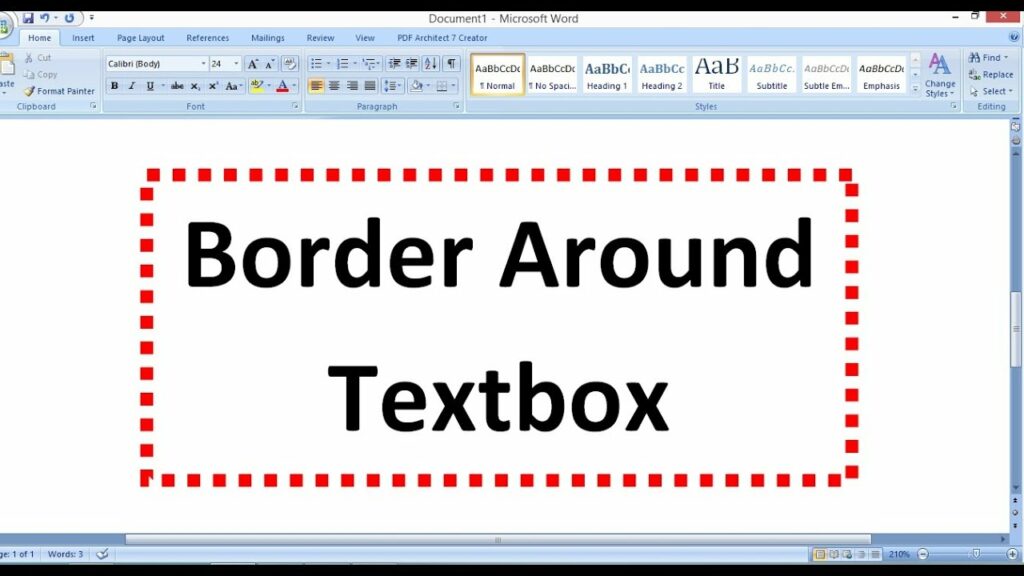Crafting Visual Appeal: A Comprehensive Guide to Inserting Text Boxes with Borders in Microsoft Word

In the vast landscape of document design, visual elements play a crucial role in enhancing the aesthetic appeal, organization, and clarity of content. Text boxes serve as versatile tools for highlighting important information, drawing attention to key points, and creating visually engaging layouts. By adding borders to text boxes, you can further enhance their visual impact and create a polished, professional look for your documents. In this extensive guide, we’ll explore the intricacies of inserting text boxes with borders in Microsoft Word, empowering you to elevate your document design with style and precision.
Understanding the Significance of Text Boxes with Borders:
Before delving into the practical aspects of inserting text boxes with borders, it’s crucial to grasp the significance of these visual elements in document design. Text boxes with borders serve multiple purposes, including:
- Emphasizing content: Text boxes with borders help draw attention to specific text or information, making it stand out from the surrounding content and guiding the reader’s focus.
- Creating visual hierarchy: By enclosing content within a bordered text box, you can establish a clear visual hierarchy within the document, distinguishing between different sections or topics.
- Adding visual interest: Borders add visual interest and structure to text boxes, enhancing the overall aesthetic appeal and professionalism of the document layout.
By incorporating text boxes with borders into your document design toolkit, you can create visually appealing and well-organized documents that captivate your audience and convey information effectively.
Basic Text Box Insertion with Borders:
Inserting a text box with a border in Microsoft Word is a straightforward process that can be accomplished using built-in tools and features. Here’s how to do it:
- Access the Insert Tab:
- Open Microsoft Word and navigate to the “Insert” tab located in the top menu bar.
- In the “Text” group, you’ll find the “Text Box” button. Click on this button to access text box options.
- Choose a Text Box Style:
- In the dropdown menu, you’ll see various predefined text box styles. Choose a style that includes a border or select “Draw Text Box” to create a custom text box with a border.
- Draw or Insert Text Box:
- If you selected a predefined text box style, simply click on it to insert the text box into your document. If you chose “Draw Text Box,” click and drag to draw the text box on the page.
- Format the Border:
- Once the text box is inserted, you can format the border by right-clicking on the text box and selecting “Format Shape” or “Format Text Box” from the context menu. In the formatting options, you can customize the border style, color, thickness, and other properties.
- Enter Text:
- With the text box selected, start typing or paste the desired text into the text box. You can resize or reposition the text box as needed to fit the content within the document layout.
Advanced Text Box Border Options:
While basic text box insertion suffices for most scenarios, Microsoft Word offers advanced features and customization options to further enhance the appearance and functionality of text boxes with borders. Here are some additional features you may explore:
- Customizing Border Styles:
- Word allows users to customize border styles using a variety of options, including solid lines, dashed lines, double lines, or custom line styles. Experiment with different border styles to achieve the desired visual effect.
- Adding Effects and Shadows:
- In addition to borders, Word enables users to add effects and shadows to text boxes to enhance their visual appeal. Access the “Effects” or “Shadow” options in the formatting menu to apply effects such as 3D rotation, reflection, or shadowing to the text box.
- Grouping and Layering Text Boxes:
- For complex document layouts, Word offers options for grouping and layering text boxes to create intricate designs or arrange content within the document. Use the “Group” or “Arrange” options in the formatting menu to manipulate text boxes as needed.
Best Practices for Text Box with Border Usage:
While text boxes with borders offer versatility and visual appeal in document design, it’s essential to use them judiciously and in accordance with best practices. Here are some tips to consider:
- Maintain Consistency:
- Use consistent border styles, colors, and thicknesses for text boxes throughout the document to ensure visual coherence and professionalism. Consistent formatting enhances readability and visual appeal.
- Balance Text and White Space:
- When using text boxes with borders, strive to achieve a balance between text and white space within the document layout. Avoid overcrowding the text box with excessive content, and ensure that there is sufficient space around the text box for visual clarity.
- Consider Accessibility:
- When designing documents with text boxes, consider accessibility guidelines to ensure that the content remains accessible to all users, including those with visual impairments. Provide alternative text or descriptions for text boxes to aid understanding.
- Test Across Devices:
- Before finalizing your document, test the appearance and functionality of text boxes with borders across different devices and display settings to ensure that they render correctly and maintain their visual integrity.
Conclusion:
Inserting text boxes with borders in Microsoft Word is a versatile and effective way to enhance document design and visual appeal. By mastering the basic insertion process, exploring advanced options, and adhering to best practices for usage, you can create documents that are not only visually appealing and well-organized but also user-friendly and accessible. Whether you’re creating reports, presentations, or marketing materials, text boxes with borders offer a versatile and powerful means of highlighting key information, organizing content, and creating visually engaging layouts. So, the next time you embark on a document creation journey in Word, remember to leverage the power of text boxes with borders to elevate your document design with style and precision, and make a lasting impression on your audience.




